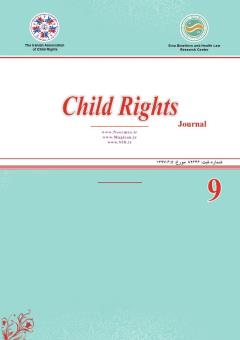Domestic Legal Order in Response to Violence against Children
Subject Areas : child rights
1 - Medical Ethics and Law Research Center, Shahid Beheshti University of Medical Sciences, Tehran, Iran
Keywords: Children Rights, Violence, Constitution, Social support, Citizen’s rights ,
Abstract :
Background and Aim: Childhood is the most sensitive period of human life in which various physical and mental dimensions of individuals are formed and developed. Hence, it is crucially important to maintain children's physical-mental health. In the present article, an attempt is made to depict the general outline of the domestic legal normative order in response to violence against children. Method: This study has been done in a descriptive-analytical way by using the library resources and especially laws. Results: Children should never be exposed to violent domestic or social situations and experience child abuse. Since children today will be responsible for society in the future, and the progress and development of the country depend on their proper upbringing and development; therefore, the issue of violence against children, which causes great harm to it, is of special concern to Iran's laws. Conclusion: In the current legal system, the response to violence against children knows no boundaries; today, there are various examples, such as violent physical and psychological punishment, parental neglect, exploitation, unhealthy cyberspace, drop out, pornography and pressures of poverty.
1. Petoft A, Abbasi M. Citizenship Rights: from Good Governance to Administrative Procedures: Justice Publication; 2017. [Persian]
2. Katozian N. Civil Law, Family. Tehran: Mizan Publications; 2010. [Persian]
3. Darijani M. Legal and criminological study of corporal punishment of children (Master Thesis), Department of Criminal Law and Criminology, Faculty of Law and Political Science. University of Tehran; 2000. [Persian]
4. Petoft A, Markaz-malmiri A. Concept and scope of the general principles of administrative law and referring possibility in the judicial procedure. The Judiciary Research Institute Publishing Center; 2016.
5. Nobahar R, Saffari F. The Requirements of a Protective Criminalization for Street Children. Criminal Justice Research. 2018; 8(2): 211-31. [Persian]
6. Zeinali AH. Innovations in the Law on the Protection of Children and Adolescents and Its Overcoming Challenges. Social Welfare Quarterly. 2003; 7: 59. [Persian]
7. Parvin K, Patoft A. Scope of legislative supervision of the decisions of the council of ministers, emphasis upon Articles 85 and 138 of the Constitution of the Islamic Republic of Iran. Public Law Studies Quarterly. 2015; 45(1): 63-82. [Persian]
8. Javanmard B. Study of the status of criminal protection of children in the Iranian legislative system and related challenges. Journal of the Bar Association. 2010; 208: 247. [Persian]
9. Asghari SS. Islamic Penal System and Response to Doubts. Tehran: Keyhan Publications; 2018. [Persian]
10. Sabet MAM, Abdollah S. Iran's preventive criminal policy against violence against children. Quarterly Journal of Crime Prevention Studies. 2020; 33: 9-51. [Persian]
11. Petoft A. The concept and instances of general principles of administrative law: Towards a global administrative law. Cuestiones constitucionales. 2020; 42: 309-55.
12. Saffari A. Theoretical Foundations of Crime Prevention. Journal of Legal Research. 2001; 34: 33. [Persian]
13. Aberandabadi AHN. Criminal Politics. Criminal Science: Collection of Articles. 2005; 2: 268. [Persian]
14. Mahdavi M. Study of children and adolescents at risk: A case study of delinquency risk factors in adolescents of Tehran Correctional Center (PhD thesis) Department of Criminal Law and Criminology, Faculty of Law and Political Science: University of Tehran; 2009. [Persian]


